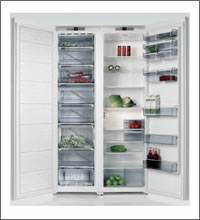
(Put an appropriate image here)
A project of the Bio 160 Agroecology Class
Name of the farm goes here
Put description of the farm here
Food Storage: Refrigeration, Dry Storage, and Safety Considerations Safe and functioning food storage and refrigeration will be essential in the larger transport process of bringing the products of the farm, into the Dining Hall's kitchens for preparation. In this effort there are three essential components. |
  |
There are two key considerations in making use of refrigeration for food storage. The first is space efficiency which is the consideration of where and how to store any food products that need refrigeration. The second is energy use, as refrigeration potentially posses the greatest energy challenge of this middle process. In this there are two suggested brands of refrigerators, Vestfrost and Gram, which can be effective purchases in considering the farms' refrigeration needs. Both provide systems for energy efficient food storage, but just as important, these systems can work with the size and space considerations of the farm through either standing refrigerators, chest refrigerators, or double-door refrigerators and can be utilized either on site, or as additional storage within the dining hall systems.
Much of the produce produced on the Carleton farm will be durable, long lasting staple foods such as hearty vegetables and herbs. Having good bulk storage methods will help ensure long term availablity of farm outputs. There are a number of systems that can be useful in considering dry storage.
a. Bulk Container Storage
So long as bulk dry foods, are stored in organized clean environments, any method of bulk storage whether through "Rubbermade" containers or shelving methods can be effective. Such storage can be assessed as outputs are considered.
b. Packaging Storage: Freeze Dry, Dehydration and Canning
These are methods of more complex long term storage and require systems of food preparation which take into account food moisture content, long term durability, and the availability of time for processes. Freeze Drying and Dehydration can be time consuming but are effective methods of storage in that they remove little to no nutritional contents of the food and can be used as an alternative for storing foods which would otherwise have a short term storage viability. Canning, will be an essential process for utilizing farm products in moments of non production. There are many reasonable canning technologies for doing so, and these can be considered as farm outputs are assessed.
There are a number of vital untakings to consider for proper safe food storage in either refrigeration or dry systems. These include;
- Storage of all food in regularly cleaned, highly monitored environments
- Storage in dry, not moist spaces, elevated from the floor
- Proper temperature considerations - most foods need to be stored in temperatures be 40 - 70 degrees Fahrenheit.
- Avoiding excessive handling, removing damaged or rotted produce, and being sure that all foods are cleaned before and after storage.
The USDA's Food Safety and Inspection Service has a list of guidelines for safe food storage which must be considered.